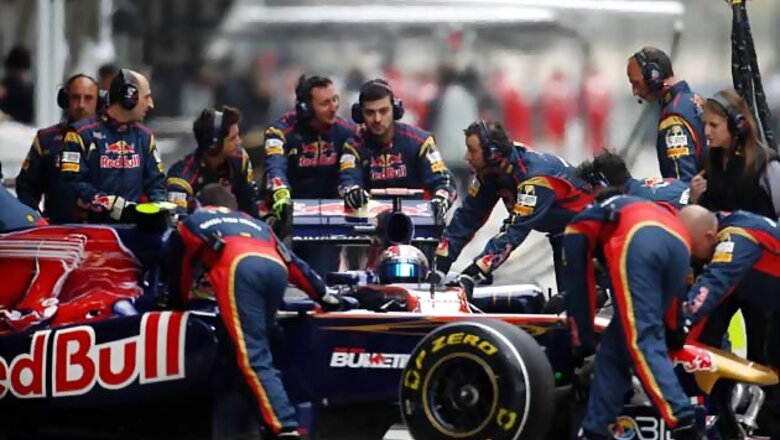
views
Silverstone: Formula One for decades has been all about the cars and drivers. This year, pit crews are finally getting their due. Desperate to gain an edge over their rivals and facing more stops due to tyre troubles, teams are investing heavily in training and equipping their crews.
The top teams have almost cut their stops in half over the past two years. Red Bull claimed they clocked the fastest-ever stop five times at the Malaysian Grand Prix this year, reaching 2.05 seconds. The previous best was 2.3 seconds set by McLaren last year. The increased speed has not come without costs.
Several drivers have seen their races go up in smoke when tyres were not attached properly. Red Bull suffered that mishap at least twice this year - the last time in Germany when the right-rear tyre from Mark Webber's car came off in the pits and hit a cameraman.
"Every time you come down the pit lane if you can be a second quicker that means with a three-stop strategy you will save three seconds of race time," said McLaren sporting director Sam Michael, whose team had the fastest pits stops for 10 races in a row last year.
"We are pretty much going two seconds quicker than what we were going two years ago. Typically a good stop was 4.5 seconds and now 2.5 seconds and two seconds is typical value," he said. "If you save one second, that is same as saving as car being one-tenth of a lap quicker for 10 laps."
Pit crews have always been crucial to an F1's team success but they often were chaotic, and speed was rarely a factor since refueling gave them plenty of time to put on fresh wheels or remove a damaged wing. The end of refueling in 2009 and then the replacement of the lollypop man - the guy holding a sign that held a car in the pits and cleared it for release - with an automated system prompted teams to give pit crews a closer look.
The result has been an overhaul of the way pit stops are conducted, with teams attempting to make them more consistent and coordinated.
The best teams look more like dance groups, with 20 to 24 people surrounding the car as it comes to a stop. In a blink of the eye, the jack men lift the car in the air, the wheel gun men have the nuts off the wheels and the wheel-off and wheel-on guys slap on new rubber. In that time, another guy adjusts the wing if needed.
"Now, the emphasis is on the time it takes to change the wheels. That is your total pit stop time," said Steve Lawrence, a Williams pit crew member who also is a mechanic on Pastor Maldonado's car. "So it has ramped up considerably in the last few years that we must get these pit stops times down ... There is more pressure but some of that is taken away by the amount of training we do."
Most fans remember a bad pit stop - a wheel nut shreds, a jack malfunctions - if it somehow ruins a race or ends a driver's day. A good stop, in contrast, often goes unnoticed but can keep the likes of Sebastian Vettel in the lead or position the triple world champion to overtake a rival.
Teams now spend huge sums to design their own equipment and improve the fitness of their teams who also work as mechanics. McLaren are working with the English Institute of Sport to hone their 24-member team's technique while Williams have partnered with Olympic champion Michael Johnson's Performance Center to work on everything from diet to eye-hand coordination to core strength.
Training has also been ramped up. Most teams have rigs to practice on in the factory and pit stops are practised as many as 70 times over a typical race weekend. Each stop is timed and videotaped for later review.
"When you had to go from 3.5 seconds down to a lower number, then you really need to be very specific and accurate on how you train because everything needs to be very synchronised to achieve that level of fast time and consistency," said Williams' chief race engineer Xevi Pujolar, whose team had its fastest pit stop this season in Spain after making changes to its crew but still is almost a second behind the top teams.
"There's still a lot of room for improvement and we are working hard to catch up to these guys that do close to two seconds," Pujolar said. "If you look at video of pit crew and how they move during pit stop, everything is so well coordinated. To achieve this level of coordination on every pits stop requires a lot of training."
Williams may be taking the most unorthodox approach. They have hired professional rugby player Davie Wells to lead their training and are considering introducing mental techniques which would help the crew envision the perfect stop. They have also rolled out a five-part video series on YouTube celebrating the virtues of the pit stop.
As teams close in on the two-second stop, they also are careful to emphasise safety.
Red Bull's mishap in Germany resulted in a $39,539 fine and, according to autosport.com, prompted the team to change procedure after finding that a crew member accidentally pressed a go signal that allowed the car to be released early.
FIA, the sport's governing body, also ruled that only team personnel and marshals will be allowed in the pits during qualifying and races. It will also seek the World Motor Sports Council approval for team personnel to wear head protection plus request a reduction in the pit speed limit from 100 kilometers per hour to 80.
"I think it's possible to get below two seconds. I think it's dangerous to put too much focus on that," McLaren team principal Martin Whitmarsh said, adding he has advised his team not to push so hard.
"I think now they are sufficiently short that in fact the odd tenth difference between the stops isn't material," he said. "What is material is the pressure we put people under to get to about a two-second stop. Every now and then it goes wrong, and so the ones that are material are the ones that go wrong because of the pressure we put on people to try and do it in two seconds, and those are the ones that are often the game-changer, not 2.3s versus 2.4s versus 2.6s."




















Comments
0 comment